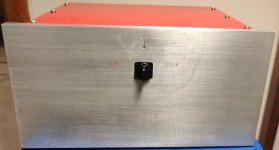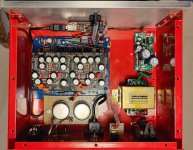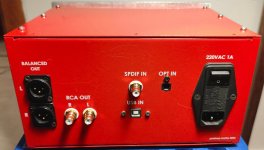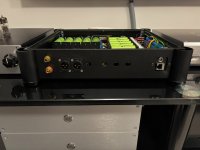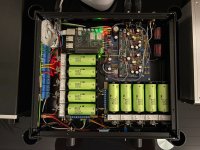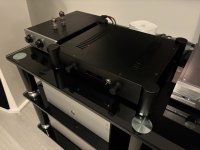sadly, you maybe right again. The spdif input doesn't work, so perhaps the WM8804 died. Unfortunately, WM8804 seems unavailable here in India. Looks like it is discontinued. Any suggestions? Could anything else other than the WM8804 have died instead? My hifi chain relies on spdif...yes, check spdif, the WM8804 might have not survived
Sorry to hear,
two options:
1. look again at Digikey and Mouser, they have them on stock - or look here for moer suppliers wm8804 octopart
2. buy a spdif to I2S converter and connect to I2S input
Hope that helps!
two options:
1. look again at Digikey and Mouser, they have them on stock - or look here for moer suppliers wm8804 octopart
2. buy a spdif to I2S converter and connect to I2S input
Hope that helps!
No sure if this is the right place to ask, but...
...say I wanted to use active DSP filters (xover, equalization), and run the I2S data from the DSP filters into a bunch of DDDACs for D/A conversion. I'd prefer running the DSP filters and xovers using a Raspberry Pi (for example Camilla DSP, but I'd be open for other solutions). Of course these I2S data streams (the DSP output) should run through a reclocker/FIFO thingy just before feeding into the DDDAC boards. Of course the reclocking should run off one unique clock so that all channels are nicely in sync.
Has anyone done something like this? Any clues or suggestions on a suitable reclocker board that handles more than two (stereo) channels (6 or 8 channels would be nice)? Other thoughts?
...say I wanted to use active DSP filters (xover, equalization), and run the I2S data from the DSP filters into a bunch of DDDACs for D/A conversion. I'd prefer running the DSP filters and xovers using a Raspberry Pi (for example Camilla DSP, but I'd be open for other solutions). Of course these I2S data streams (the DSP output) should run through a reclocker/FIFO thingy just before feeding into the DDDAC boards. Of course the reclocking should run off one unique clock so that all channels are nicely in sync.
Has anyone done something like this? Any clues or suggestions on a suitable reclocker board that handles more than two (stereo) channels (6 or 8 channels would be nice)? Other thoughts?
As far as I know, no one did this, at least not asking any questions to me. What normally happens, when things are a bit out of the box. So let me give you my 2 cents:
1. use 3 or 4 FiFoPi's with one master clock going to the 3 or 4 FiFoPi boards
2. do a simple flip flop reclocking with your master clock with this FIFO Reclock Jitter Eliminator for 8 Channel DAC:
https://www.diyinhk.com/shop/audio-kits/165-fifo-reclock-jitter-eliminator-for-8-channel-dac.html
1. use 3 or 4 FiFoPi's with one master clock going to the 3 or 4 FiFoPi boards
2. do a simple flip flop reclocking with your master clock with this FIFO Reclock Jitter Eliminator for 8 Channel DAC:
https://www.diyinhk.com/shop/audio-kits/165-fifo-reclock-jitter-eliminator-for-8-channel-dac.html
I presume you are going to have a discrete i2S stream for each pair of left and right drivers ? Otherwise you will need a software/hardware solution to separate out all the channels . . .No sure if this is the right place to ask, but...
...say I wanted to use active DSP filters (xover, equalization), and run the I2S data from the DSP filters into a bunch of DDDACs for D/A conversion. I'd prefer running the DSP filters and xovers using a Raspberry Pi (for example Camilla DSP, but I'd be open for other solutions). Of course these I2S data streams (the DSP output) should run through a reclocker/FIFO thingy just before feeding into the DDDAC boards. Of course the reclocking should run off one unique clock so that all channels are nicely in sync.
Has anyone done something like this? Any clues or suggestions on a suitable reclocker board that handles more than two (stereo) channels (6 or 8 channels would be nice)? Other thoughts?
Happy to report it's up and running in full. Couldn't source a WM8804G, but discovered that a cheap raspi spdif HAT used it. So bought that board, and transplanted. Using a Sigma 11 regulator. Haven't done the spdif in, but optical in works fine (which is what I need primarily). USB works fine too.Sorry to hear,
two options:
1. look again at Digikey and Mouser, they have them on stock - or look here for moer suppliers wm8804 octopart
2. buy a spdif to I2S converter and connect to I2S input
Hope that helps!
Attachments
Hi Doede,
I get a loud pop when the music starts. Happens everytime I start from silence. Dont have this with any other DAC. Any ideas on what could be causing it?
My chain goes Raspi with picoreplayer/LMS/squeezelite->spdif HAT->behringer DEQ2496->to DAC via optical->analog preamp via RCA->amp (USSA-5 monoblocks). I am playing spotify streams mostly.
I get a loud pop when the music starts. Happens everytime I start from silence. Dont have this with any other DAC. Any ideas on what could be causing it?
My chain goes Raspi with picoreplayer/LMS/squeezelite->spdif HAT->behringer DEQ2496->to DAC via optical->analog preamp via RCA->amp (USSA-5 monoblocks). I am playing spotify streams mostly.
Last edited:
honestly, I have no idea. I have no pops in my system? does it also pop when you use a CD player with spdif connection for example?
Most commercial DACs are in mute when no music is playing. If the source would "generate" a plop at start, indeed this will not be audible. The DDDAC has no mute.
Another check point: are you playing with analog volume control? (after the DAC) or with digital control (And the chain is always at high volume) ? this can cause a plop to be (more) audible
Most commercial DACs are in mute when no music is playing. If the source would "generate" a plop at start, indeed this will not be audible. The DDDAC has no mute.
Another check point: are you playing with analog volume control? (after the DAC) or with digital control (And the chain is always at high volume) ? this can cause a plop to be (more) audible
Didn't check with a CD player - don't have one here. I use the digital volume control (on LMS) since it's more convenient. My pre doesn't have a remote and laziness usually prevails.
Appreciate your point about commercial DACs, but I also have a soekris 1021 and that doesn't pop. Maybe it's got mute. It's not a biggie - was just wondering why and checking if there's an obvious reason and fix.
Appreciate your point about commercial DACs, but I also have a soekris 1021 and that doesn't pop. Maybe it's got mute. It's not a biggie - was just wondering why and checking if there's an obvious reason and fix.
Hi @dddac. Appreciate if you could clarify one query. You had prescribed using a choke with up to 0.5ohms and a 1 ohms resistor in series for your psu. I am in the pursuit of finding a higher inductance choke for this purpose. Tell me if is it possible to replace a 0.5ohm dcr choke and a series 1R with a higher inductance choke which has its dcr itself as 1.5R in total.
TLDR: Just wanted to say the DDDAC is still the king.
Not sure what happened, but I somehow got hold of a Holo May NOS DAC and hooked it up to my Blue Hawaii and Stax X9000. My ears like what they heard. A lot. At least as long as the May was actually configured to run in NOS mode. I kept listening like this for quite a while, but I kept thinking... is it better than a DDDAC? So I started comparing it to my DDDACs*. Long story short the May sounds very similar than my DDDACs, but the DDDACs have tiny little bit more air and separation of small things. One such example is "Musica Nuda / Live at FIP", "Come together" at 1.06 where you hear the audience join the song. Listening this on the May for a few times, I thought it was just one person. With the DDDAC its's very clear that it's actually several persons.
* The first DDDAC is a modified Audio Creative build with four DAC decks, the "magic" CLC PSU, and ReClock Pi + Accusilicon clocks (my mods: fixed grounding, changed to cap coupling of balanced outputs). The other DAC is my own build build with 8 DAC decks, a beefy CLC PSU, a basic Ian + Accusilicon reclocker, and cap coupled balanced out.
Not sure what happened, but I somehow got hold of a Holo May NOS DAC and hooked it up to my Blue Hawaii and Stax X9000. My ears like what they heard. A lot. At least as long as the May was actually configured to run in NOS mode. I kept listening like this for quite a while, but I kept thinking... is it better than a DDDAC? So I started comparing it to my DDDACs*. Long story short the May sounds very similar than my DDDACs, but the DDDACs have tiny little bit more air and separation of small things. One such example is "Musica Nuda / Live at FIP", "Come together" at 1.06 where you hear the audience join the song. Listening this on the May for a few times, I thought it was just one person. With the DDDAC its's very clear that it's actually several persons.
* The first DDDAC is a modified Audio Creative build with four DAC decks, the "magic" CLC PSU, and ReClock Pi + Accusilicon clocks (my mods: fixed grounding, changed to cap coupling of balanced outputs). The other DAC is my own build build with 8 DAC decks, a beefy CLC PSU, a basic Ian + Accusilicon reclocker, and cap coupled balanced out.
I Just hooked up my dddac 1794 mk 2 with the blueboard. The 12 volt powersupply dropped to 8.4 volt when hooked up. I checked and without the load it is 12volt .It is a john brooskie 12 volt regulated powersupply capable off 1.7 amps the transformer is 12 volt 1 amp. From what I can read this should be enough current.
Any suggestions on what is wrong? Can something be wrong on the board drawing to much current?
Any suggestions on what is wrong? Can something be wrong on the board drawing to much current?
Remote diagnostics ist always difficult… but a 12 volt transformer with 1A is way too small for this. If you want DC 12V 1A from this brooksie PSU this cannot work. As I do not know the needed headroom, drop out voltage, and no idea what your input filter is as well what heat dissipation it can handle ( filter in the sense of how much uF) I cannot advice any further on the required size for the transformer
Try disconnecting the DDDAC board and check that the 12v supply is putting out proper voltage with no load. If so, then load it with some other load - resistors or some other board that draws less than 1Amp. I also suspect your transformer is not up to the task. Try to find the original documentation for the PS to get recommendations for transformer size.
I think I fond the fault. A smoothing resistor placed beetwe the positiv sides off smooding caps was 30 ohm now it is 1 ohm as the manual says. In the long run I will probebly try a biger transformer.
A battery powered DDDAC/RPi player... 🙂
I had some A123 Systems 26650 LiFePo cells lying around as well as well as a DDDAC board that I had not used for a few years. So I decided to put them to use. I had earlier made two charging PCBs using some charging chips (from e-bay) and aux relays, so that part was ready to use. Next I did a proto board setup and evertyhing seemed to work very well and I really liked the sound too! Very organic and natural to my ears.

In this setup I had three batteries in series giving ~10V for the RPi via a simple LM317 5V regulator. Also there is 3V feed for the Ian Canada reclocking board and four batteries in series feeding the DDDAC pcb. Later on I added separate 3V battery supplies for the DDDAC's PCM1794 and removed the regulators on the pcb.
Since I liked the sound very much after the proto phase I decided to continue and put it in a box. Since I wanted to keep the expences low I sacrified my DIY pre amp's case for this. For switching the battery supplies on/off I used a ready made aux relay pcb. The design of the power supply circuitry is described below:

The basic idea is to have a ON-OFF-ON switch to control the external 5V operation/charging supply whether to turn the player on or to put in battery charging mode.
I also attached some pictures of the final "product". There are both RCA and balanced XLR outputs available and also a LCD display showing the voltage of the most power hungry RPi feed. The LCD can be switched on/off from the little switch on front panel. Playing time is about 5-6 hours. The RPi is using Ropieee software and I'm using it as a Roon end-point device, so all the controls are via iPad/iPhone.
I had some A123 Systems 26650 LiFePo cells lying around as well as well as a DDDAC board that I had not used for a few years. So I decided to put them to use. I had earlier made two charging PCBs using some charging chips (from e-bay) and aux relays, so that part was ready to use. Next I did a proto board setup and evertyhing seemed to work very well and I really liked the sound too! Very organic and natural to my ears.
In this setup I had three batteries in series giving ~10V for the RPi via a simple LM317 5V regulator. Also there is 3V feed for the Ian Canada reclocking board and four batteries in series feeding the DDDAC pcb. Later on I added separate 3V battery supplies for the DDDAC's PCM1794 and removed the regulators on the pcb.
Since I liked the sound very much after the proto phase I decided to continue and put it in a box. Since I wanted to keep the expences low I sacrified my DIY pre amp's case for this. For switching the battery supplies on/off I used a ready made aux relay pcb. The design of the power supply circuitry is described below:
The basic idea is to have a ON-OFF-ON switch to control the external 5V operation/charging supply whether to turn the player on or to put in battery charging mode.
I also attached some pictures of the final "product". There are both RCA and balanced XLR outputs available and also a LCD display showing the voltage of the most power hungry RPi feed. The LCD can be switched on/off from the little switch on front panel. Playing time is about 5-6 hours. The RPi is using Ropieee software and I'm using it as a Roon end-point device, so all the controls are via iPad/iPhone.
Attachments
Thanks for this detailed and wel documented report! Really appreciated. You have been making a very clever use of the batteries.
Also, nice chassis you built up. great Job 😎
I have only one question left: you feed the DDDAC "13V" with 4x A123, what is the minimum total voltage before you charge again? My recommendation was always to keep the DC at 12.5 V DC. 12 is alo fine but a bit on the edge for the 7810-regulator headroom, hence I suggest putting 12.5 at the DC input. More is no real problem, as long as it not beyond 15 Volt or so; otherwise, the 7810 might get a bit hot. well two questions: til what end voltage do you charge? 😉
Also, nice chassis you built up. great Job 😎
I have only one question left: you feed the DDDAC "13V" with 4x A123, what is the minimum total voltage before you charge again? My recommendation was always to keep the DC at 12.5 V DC. 12 is alo fine but a bit on the edge for the 7810-regulator headroom, hence I suggest putting 12.5 at the DC input. More is no real problem, as long as it not beyond 15 Volt or so; otherwise, the 7810 might get a bit hot. well two questions: til what end voltage do you charge? 😉
- Home
- Source & Line
- Digital Line Level
- A NOS 192/24 DAC with the PCM1794 (and WaveIO USB input)
